Cast Iron vs Enamel Dutch Oven – Similarities
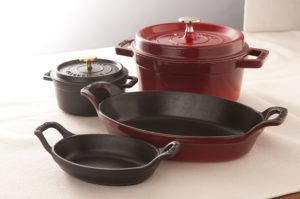 A Dutch oven is a large pot with thick walls and a tight-fitting, heavy lid to keep steam from escaping and retain moisture in your cooking. That is why it is often the go-to cookware for slow-cooking, braising, and stewing. Typically, Dutch ovens are made of cast iron because of its ability to absorb and retain heat. There are also Dutch ovens that are made of stainless steel but there are pros and cons to each as can be seen in the All Clad vs Le Creuset debate.
A Dutch oven is a large pot with thick walls and a tight-fitting, heavy lid to keep steam from escaping and retain moisture in your cooking. That is why it is often the go-to cookware for slow-cooking, braising, and stewing. Typically, Dutch ovens are made of cast iron because of its ability to absorb and retain heat. There are also Dutch ovens that are made of stainless steel but there are pros and cons to each as can be seen in the All Clad vs Le Creuset debate.
An enamel Dutch oven is also often made of cast iron. It is just that a layer of enamel is added on top of the cast iron by fusing them together using extremely high temperatures. So, an enamel Dutch oven can also absorb and retain heat just as well because at its core, it also has a cast iron construction.
Is Enameled Cast Iron Better Than Cast Iron Dutch Ovens?
This is where the differences will come into play as you decide whether an enamel Dutch oven will be a better buy than a cast iron one or vice-versa. Different people will place different emphasis on each of the features. So, what works for one may not necessarily work for the other.
Appearance
Is the cookware color important to you? If it is, then the answer is obvious in the cast iron vs enamel Dutch oven dilemma. There are plenty of colors to choose from for the enamel version even for inexpensive brands like the Lodge Dutch oven. You will get a prettier pot that will match your kitchen decor or complement your existing pots and pans.
As for cast iron Dutch ovens, they will not be as beautiful. There are no color options and they are typically bought for their durability and cooking performance rather than appearance.
Maintenance
A cast iron Dutch oven will require regular maintenance. You need to season it before use and you might also need to re-season it every now and then to keep it from sticking. It is prone to rust if not given enough care and attention such as soaking or leaving it wet after washing.
On the other hand, enameled cast iron Dutch ovens do not require seasoning. The enamel layer protects it from rust and hence, it is definitely the easier one to maintain compared to cast iron.
Durability
While it is nice to have cookware that requires little to no maintenance and looks beautiful in the kitchen, the downside is it is not as tough as a raw cast iron piece. The enamel layer can chip or crack. You need to use it with more caution and avoid metal utensils to protect its coating. The outer layer may also chip if you bump it against a hard surface while washing or cooking.
You would not have this problem with a plain cast iron Dutch oven. There is no worry over how long the enamel layer would hold up. You don’t have to treat it as gently and you can even restore a rusty-looking pot back to its original condition. It is not uncommon for cast iron cookware to be passed down from one generation to the next. They can last you a lifetime and they are a better choice if you are looking for durability.
Stickiness
For uncoated cast iron cookware, the cooking surface can be sticky, especially when it is still new. You need to season it and use it regularly to build a layer of natural nonstick coating. That is why used cast iron skillets that are passed down from the older generation are such prized possessions in the family. They are very easy to cook with and perfect for searing and browning.
Most enamel cast iron Dutch ovens have a smooth cooking surface. They may be a little sticky but, unlike bare cast iron, you cannot build the same layer of seasoning on its cooking surface. Little improvement can be made on it compared to the uncoated version which gets slicker with use.
Acidic Food
This is one of the major disadvantages of cooking with bare cast iron – acidic food will interact with the iron. The seasoning can get damaged and your food may also end up having a metallic taste. Thus, you need to be extra careful when your recipes require ingredients such as tomatoes, chilies, and vinegar.
While it doesn’t harm your health if minute amounts of the metal leach onto your food, nobody enjoys having a metallic taste to their dishes. If your Dutch oven is well-seasoned, you may still be able to come up with perfect-tasting food. But it is still a big no to cook acidic food in a bare cast iron pot on a regular basis. Neither should you leave acidic food in the pot for long as it will strip away the seasoning that you have worked so long to build.
On the other hand, an enamel cookware has no such issues. You can cook tomatoes in it as the cast iron is covered by the enamel layer which is non-reactive to the acidity in the food. When you buy an enamel Dutch oven, you don’t need to have a different pot on standby for recipes that require acidic ingredients.
Which Is More Expensive?
 Generally, enamel cast iron Dutch ovens are more expensive than the uncoated ones. On the high end, Staub and Le Creuset are the 2 brands that most people will long for and they sell for more than $300 for a mid-sized Dutch oven. The more affordable ones would be Lodge and Tramontina and they cost only a fraction of the price that you would pay for Staub and Le Creuset. The selling price of these is not much higher than an uncoated cast iron Dutch oven.
Generally, enamel cast iron Dutch ovens are more expensive than the uncoated ones. On the high end, Staub and Le Creuset are the 2 brands that most people will long for and they sell for more than $300 for a mid-sized Dutch oven. The more affordable ones would be Lodge and Tramontina and they cost only a fraction of the price that you would pay for Staub and Le Creuset. The selling price of these is not much higher than an uncoated cast iron Dutch oven.
However, these cheaper enamel Dutch ovens are made in China. The French-made ones are beyond the budget of many and some people also feel that they are way over-priced for a single pot.
Of course, some people may feel uncomfortable with the safety aspect of Chinese-made cookware. If that is the case, you can still get made in America cookware that is highly affordable with the Lodge bare cast iron sets including skillets and Dutch ovens. The downside is you won’t enjoy the benefits of an enamel cookware but as a trade-off, you will get peace of mind of a Made in the USA product.
Perhaps the conclusion to the cast iron vs enamel Dutch oven debate could be decided by how receptive you are to a higher level of maintenance for your cookware. Many people get put off by the prospect of the seasoning and re-seasoning process and would rather settle for an enamel Dutch oven even though they may have a shorter lifespan.
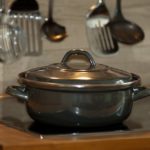
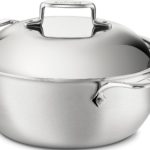
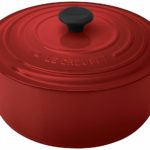
 0
0 

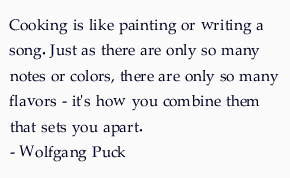

Speak Your Mind